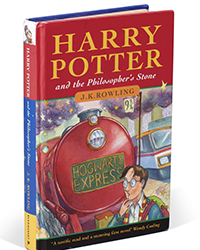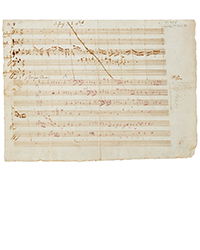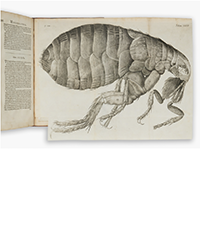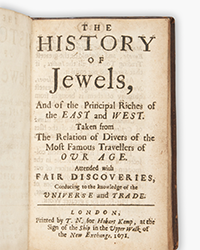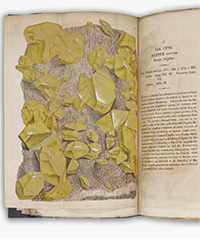Eric Caren, the remarkable collector of first and important printings, after two sales at Swann and two more at Bonhams has given his sale of very important material to Christie’s to be sold on June 15th. This type of material is quickly coming to be expected in the rooms and for that Mr. Caren will be remembered for his innovative approach to collecting. He has sailed into the field’s conventional wisdom and emerged as a prophet.
Here is Christie’s perspective on his upcoming material.
On June 15, Christie’s New York will auction The Eric C. Caren Collection: How History Unfolds on Paper as a single-owner section leading off the sale of Fine Printed Books & Manuscripts including Americana. The 109 lots of this selection span from the 16th to the 20thcenturies and represent some of the best of Caren’s world-renowned collection.
Collectors and curators of historical paper are no strangers to Eric Caren’s name. It’s been about half a century since he first ventured into a local abandoned house to emerge with armfuls of old newspapers and carry them triumphantly home. Over the decades Caren has retained that passion and energy and honed it into a focused goal: to collect the major events of human history in forms as close as possible in both time and place to the events themselves. The results—eyewitness letters, same-day newspapers, broadsides, etc.—all bear witness to history with striking immediacy and emotional force. It is Caren’s appreciation of dramatic moments that might make him particularly well-suited to selling at auction, with its tales of both hidden bargains and fierce competition. The Christie’s sale is his fifth venture to the auction block and there are two more auctions planned at Cowan’s later this year. What makes the Christie’s sale special is that it includes, in his own words, the “crème de la crème” of his archive, and is “as good as it gets either due to content, display value, rarity, provenance or a combination of these factors.” The just over 100 lots are expected to bring over $1 million.
One very timely theme in the Christie’s sale is the patriotic press. The appetite for news has been so extraordinary in history; it is good to be reminded of the great dangers journalists have endured to bring the public fresh information. There are examples in this collection of the extremely difficult circumstances under which news was both gathered and printed.
The first such lot is a December 23, 1734 issue of John Peter Zenger’s newspaper, The New-York Weekly Journal printed while Zenger was in jail. The New-York Weekly Journal was the first newspaper in America to be forthrightly political and Zenger was soon charged and imprisoned for seditious libel. In this very paper Zenger describes how he was harassed by henchmen of the Sheriff before his arrest and even, “deny’d the Use of Pen, Ink and Paper.” Zenger was eventually found not guilty thanks to the eloquence of his counsel, Andrew Hamilton, and the case is considered the first major victory for freedom of the press in North America.
Probably the most iconic “freedom of the press” newspaper is William Bradford’s legendary Halloween 1765 issue of the Pennsylvania Journal. With the loathed Stamp Act set to take effect the following day, Bradford set up his entire front-page as a tombstone and announced that he was suspending publication: “Adieu, Adieu to the Liberty of the Press.” Bradford’s ire is expressed in woodcuts of skulls and crossbones, shovels and pickaxes and on the back page there is an image of a coffin captioned: “The last Remains of the Pennsylvania Journal, Which departed this Life, the 31st of October, 1765 of a Stamp in her Vitals, Aged 23 Years.” Happily for Bradford, about six months later he also published the extremely rare first broadside American printing of the repeal of the Stamp Act. This was a Pennsylvania Journal extra dated May 19, 1766 and it is the following lot in the Caren sale.
Other papers on the theme of patriotic journalism include one of the very earliest political cartoons, being an elaborate woodcut cruelly lampooning a Philadelphia loyalist, in the Pennsylvania Chronicle, September 19, 1772; a very rare and important broadside describing the Boston Tea Party, likely the only copy extant in private hands, being published by the Pennsylvania Journal on Christmas Eve, 1773 (lot 228); and a full front-page printing of Thomas Paine’s American Crisis No. 1, “these are the times that try men’s souls…,” possibly the single-most inspirational polemic of the American Revolution, in the Connecticut Gazette, January 17, 1777 (lot 242). The capstone of these wonderful incitements to arms is found in a unique extremely large banner headline “LAUS DEO!” announcing the surrender of Cornwallis on the same day that Congress first heard of it. This is very likely the first printing of the news that secured American independence, printed in Francis Bailey’s The Freeman’s Journal on October 24, 1781. The conclusion of the War was followed by a struggle to form a new government. Lot 252 is a rare and spectacular front-page printing of the United States Constitution. There is also a probable first printing of the final Bill of Rights published in the leading Federalist newspaper of the day, The Gazette of the United States (lot 254).
The War of 1812, considered the “Second American Revolution,” also provided us with a national anthem. The Caren Collection includes both the first obtainable printing of any portion of Francis Scott Key’s “The Star Spangled Banner” (lot 274) on September 21, 1814 in the Baltimore Patriot and the earliest obtainable full printing of the poem published the next day in the Daily Federal Republican (lot 275). Newspapers were under attack during the War of 1812: lot 272 is a black-bordered broadside headed “Riot in Baltimore” describing the mob attacks on the offices of the Federal-Republican, long hostile to the Madison administration.
Newspaper offices under attack were clearly difficult places in which to publish news. The Caren Collection also includes examples of broadsides printed on army field presses from the scenes of war. One of the most evocative items in the sale is a Confederate broadside in which Robert E. Lee thanks his men for their bravery at Gettysburg, printed from the field during the retreat from that battle. Lee’s address was very stirring but it could never have fully succeeded in rallying the spirits of the Confederacy after the epic losses at Gettysburg. This modest slip of paper is misprinted and worn, altogether an extremely haunting survival.
Another compelling aspect of the Caren Collection is the number of eyewitness accounts. One of the great treasures in the sale is an original deposition used during the Salem Witch Trials. Here, a teenage girl gives testimony against her neighbor that helped send the woman to the gallows for witchcraft. This is an exceptional rarity as contemporary manuscripts from the Salem trials almost never come to market. This one describes in vivid detail how the deponent had her hair pulled and was thrown from her chair by the spectral image of a poor widow.
Another item redolent of colonial violence, and rarer still than the Salem document, is a letter dating from the 1704 Deerfield Massacre. The writer offers moral support to a father of a woman taken captive during the French and Indian raid on the frontier outpost. In part (spelling modernized), “I cannot with my pen express the concernedness of spirit that is in me for you and my dear cousin that is led captive by the bare-backed heathen … it is my daily request that God will support her in body and spirit & her bodily captivity may prove to her spiritual enlargement.” The abductee, Hannah Chapin, was forcibly marched into Canada but finally ransomed in 1706.
Christie’s will be offering an entire manuscript journal covering the years at the start of the Revolutionary War, written by a patriot who lived inside British-occupied Boston for nearly a year. Timothy Newell was a Boston Selectman and he described the battles of Lexington, Concord, Bunker Hill from his own unique perspective. This is one of the few records of its kind in private hands (lot 232).
One of our favorite eyewitness accounts is a vivid, handwritten letter by a personal friend of General George Custer. He writes on June 28, 1876 to wife after finding the General and his command slain on the battlefield at Little Big Horn. “His expression is serene and peaceful—of course perfectly naked,” he wrote. Despite his sorrow for his fallen commander he still feels, “Bad generalship on Custer’s part the cause & do not like to say this – but I do.” (Lot 298)The lot preceding the Custer is yet another exciting first-person letter, this one from an African-American Civil War soldier written to his former captain and honoring his sacrifice “for the rights and elevation of the Colored race.” Included is a carte-de-visite photograph of the soldier, Richard H. Etheridge of the 36th Infantry.
Also of note in this category is a sensational letter by a wealthy survivor of the sinking of the Titanic in which she testifies that Bruce Ismay told her he would speed up the ship despite the danger of icebergs (her statement would make international headlines and cement Ismay’s abysmal reputation, lot 304); a Gold Rush letter describing the capture and killing of Joaquin Murieta, the “Robin Hood of El Dorado” (lot 283); a nearly 300-page manuscript by a settler on the Oregon Trail (lot 285); and a letter by the founder of Tombstone, Arizona explaining how he came to give that name to the notorious settlement (lot 299).
The ultimate lot from the Eric Caren Collection takes us right into the 20thCentury and rounds out the history of communications as witnessed throughout the sale. It’s the foundation of the Internet: the breakthrough 1974 article describing the invention of TCP/IP Protocol with lengthy inscriptions by both “fathers of the Internet,” Vint Cerf and Robert Kahn describing the experience. Eric Caren befriended Cerf who inscribed it and then kindly forwarded the article to his partner Kahn for another inscription, thus obtaining manuscript narratives from both inventors describing arguably the biggest game changer in recorded history. From the Pony Express to the Internet, an auction of the Eric Caren Collection is news we all want to hear about.
The sale’s catalogue can be viewed both on Rare Book Hub’s upcoming auction search and on Christie’s website.
The auction will take place Thursday June 15, 2007 in New York at 2pm. Exhibition times are the following
Saturday, June 10, 10am-5pm
Sunday, June 11, 1pm-5pm
Monday, June 12, 10am-5pm
Tuesday, June 13, 10am-5pm


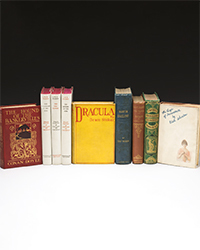
![<b>Heritage, Dec. 15:</b> John Donne. <i>Poems, By J. D. With Elegies on the Author's Death.</i> London: M[iles]. F[lesher]. for John Marriot, 1633. <b>Heritage, Dec. 15:</b> John Donne. <i>Poems, By J. D. With Elegies on the Author's Death.</i> London: M[iles]. F[lesher]. for John Marriot, 1633.](https://ae-files.s3.amazonaws.com/AdvertisementPhotos/8caddaea-4c1f-47a7-9455-62f53af36e3f.jpg)
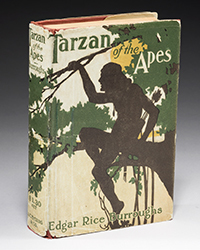
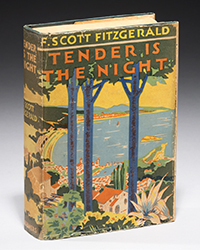
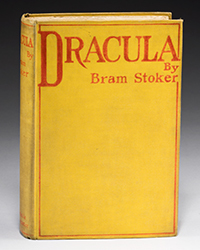
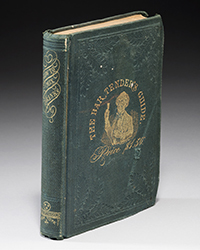

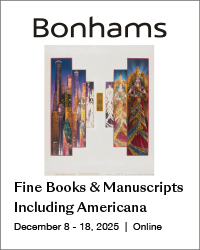

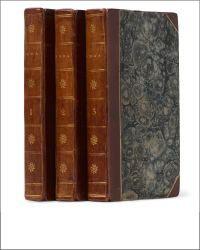
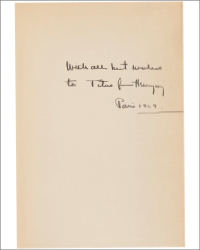
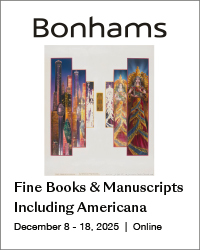
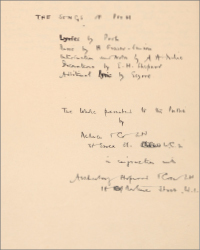

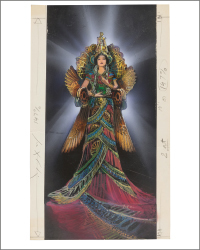
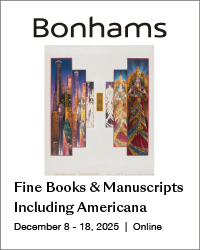
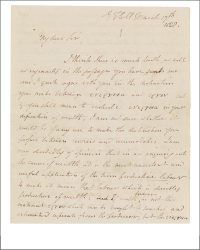
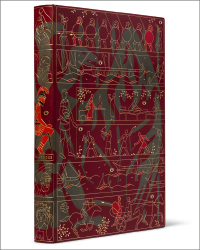
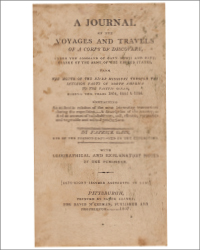
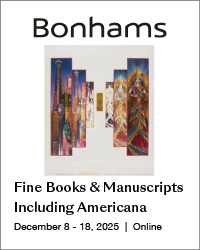
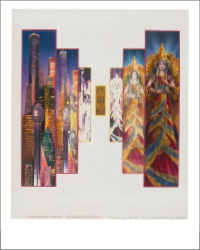
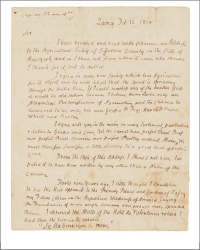

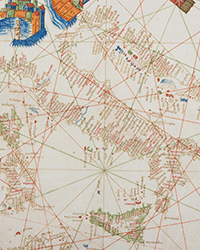
![<b>Sotheby’s, Dec. 11:</b> Darwin and Wallace. On the Tendency of Species to form Varieties..., [in:] <i>Journal of the Proceedings of the Linnean Society,</i> Vol. III, No. 9., 1858, Darwin announces the theory of natural selection. £100,000 to £150,000. <b>Sotheby’s, Dec. 11:</b> Darwin and Wallace. On the Tendency of Species to form Varieties..., [in:] <i>Journal of the Proceedings of the Linnean Society,</i> Vol. III, No. 9., 1858, Darwin announces the theory of natural selection. £100,000 to £150,000.](https://ae-files.s3.amazonaws.com/AdvertisementPhotos/00d5fd41-2542-4a80-b119-4886d4b9925f.png)
